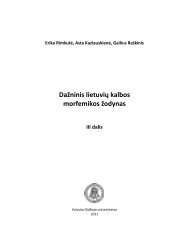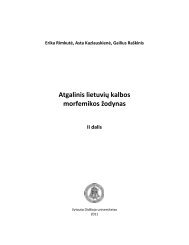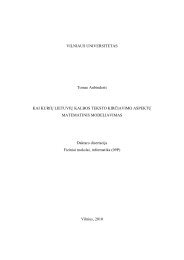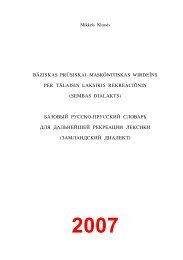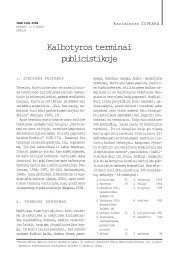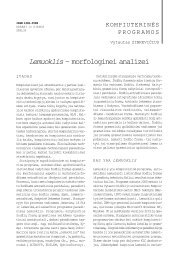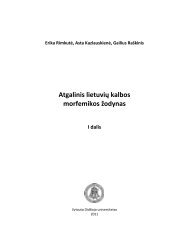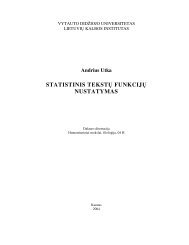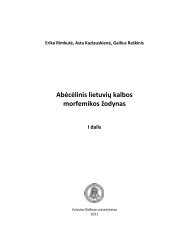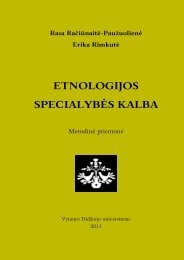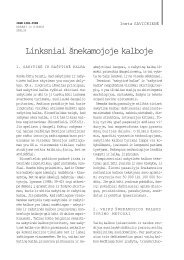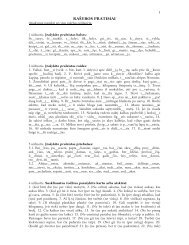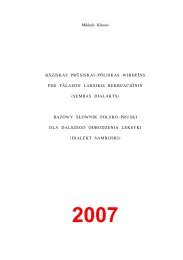HISTORICAL GRAMMAR OF OLD PRUSSIAN
HISTORICAL GRAMMAR OF OLD PRUSSIAN
HISTORICAL GRAMMAR OF OLD PRUSSIAN
You also want an ePaper? Increase the reach of your titles
YUMPU automatically turns print PDFs into web optimized ePapers that Google loves.
30<br />
V. Maþiulis<br />
ing” and I consider it to be a derivative with a suffix adj. fem. *-en` from<br />
adj. (pc. pt. pass.) Pr. *karta- ‘(what is) hung’ Lith. k³rti etc.). Cf. more detailed in PEÞ II 131–134. Pr. (E) gle[u]ptene<br />
‘mouldboard’ = *gl’aubtenç or *gl’aubtinç arose in the same way (PEÞ II<br />
275 f.).<br />
For Pr. suf. *-în` cf. krixtieno (E) ‘earth-swallow’ = *krîkstîn¯É (PEÞ<br />
II 275 f.).<br />
* 54. Adjctives with a suf. *-en- (: *-an-) produced: glosano ‘slowworm’<br />
(PEÞ I 383 f.), pelanno ‘hearth’ (PEÞ III 247) and pelanne ‘ashes’,<br />
warene ‘copper cauldron’ (PEÞ IV 220), wissene ‘ledum (palustre)’ (PEÞ<br />
IV 255).<br />
* 55. Pr. suf. *-men- was used to derive consonant-stem nouns,<br />
e.g.: Pr. (E) semeno ‘plover (Brachvogel)’ = *sçmen¯É < adj. (fem.) *sçmen`<br />
WBalt., EBalt. Latv.<br />
*ðû- ‘to sew’, cf. Pr. (E) schumeno), as well as from adjectives (Balt. dial. *plesa-, cf. Pr. (E)<br />
plasmeno – PEÞ l.c.), or substantivized adjectives (Balt. *ƒzeltan, cf. Pr. (E) sealtmeno – PEÞ l.c.).<br />
This derivation was no younger than Common (or at lest West) Baltic epoch, therefore could not<br />
be productive in historical Prussian. – L.P.<br />
19 Suf. *-in-, *-în- meant origin or belonging to a group (sort), and were used to derive nouns and<br />
adjectives from nouns. They were productive in Prussian, cf. Pr. fem. *dein` (cf. acc. sg. deinan<br />
III) ‘day’ --> deininan (III) ‘daily’, *kaims (cf. caymis E) ‘village’ --> acc. sg. kaimînan (III)<br />
‘neighbour’. This root (similarly to Lith. k³imas ‘village’, ki…emas ‘farm, yard’, Latv. cÑems ‘idem’)<br />
represents a “centum” exception of satemization in a “satem” langiage – cf. its regular “satem’<br />
counterpart Pr. seimîns III, Lith. ðeim$, Latv. saime, ORus. ñºìüÿ. For regular correspondences<br />
in “centum” languages cf. Go. haims ‘village’, Gk. êþìç ‘idem’. Lith. k³imas is considered to be



